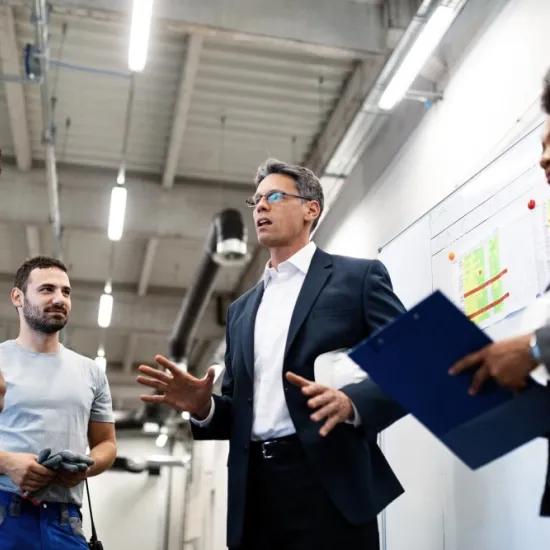Esco Couplings manufactures various types of couplings for (rail) vehicles and other applications, mostly in small series and with a large variation. In order to continue to meet the demands of the customers, the company made some fundamental changes in the areas of production and general organisation. In doing so, it followed the principles of quick response manufacturing.
Esco Couplings started as a small sales organisation and grew into a leading international player, specialising in mechanical connections. The company has two locations in Belgium - in Diegem and in Saintes - and two in Asia.
The company serves two large target sectors - transport and industry. The company produces various types of products for the transport sector: small series for both new and recurring orders from all over the world. For industry, on the other hand, the company has a large mix of products, ranging from standard to very customer-specific.
Changing demands from the market
The rail sector is the main customer for the Transport department. This sector is a world in itself, with its own quality standards, in which Esco is completely at home. The production of couplings for train undercarriages (boogies) has been strongly optimised in recent years. However, this involves highly variable products, with variation in length, diameter and choice of materials. The company aims at standardisation in order to be able to manufacture these as efficiently as possible, but this is not enough by itself. Starting out with the production department organised in the usual way, they began by implementing ‘lean’ principles.
Customer requirements have changed rapidly in recent decades: expectations changed for almost every product, the production processes became more complex, the variation became larger and the lead times had to be shorter. In order to continue to meeting all these requirements while remaining competitive, the company not only wanted to be open to new ideas and methodologies, but also to work proactively. Time was the main key element here.
Full organisation in accordance with QRM
That is how Esco Couplings came to implement QRM in 2012. This strategy is able to achieve a lead time reduction despite large product variability. In concrete terms, the company aims to implement it across the entire company, from sales and engineering through order processing to production and invoicing.
To do this at Esco Couplings a few things had to be dealt with first. The starting point is that the lead time is a complex action of people, machines and materials. To ensure that the whole company was on the same page, so to speak, all employees followed a QRM training course. Production director Stef Huybrechts took the lead in this and thoroughly immersed himself in QRM. (Stef is co-founder of QRIS and lecturer in the QRM Alpha Specialist training course.)
The effect of this on the organisation included a number of physical interventions, including the setup of a production cell and a Q-ROC ('quick response office cell').
A special production cell was started up in which QRM was used. Instead of working with different departments, the entire production chain was put together in the cell according to the logical sequence of processing. Investments were also made in machines to create extra capacity. The production of special parts and the packaging department were separated aside from the rest of the production. In this way, they managed to create a better flow.
Teamwork and communication
Another intervention was to switch to working in teams. When the teams were set up a good deal of effort was put into coaching them. Sufficient time is also made available to involve the team members in the production process. Choosing QRM also meant that the initiative was entrusted to the team, cross-training was introduced and 'time' (and the measurement) of it became the main focus.
In addition, much attention was paid to communication between the various departments. Before the arrival of QRM there was, for example, communication between two buildings - the office and the production hall - which was cumbersome. This had to become more efficient.
To optimise communication between production and engineering, sales and the invoicing service, a Q-ROC was set up in the same building, close to the production cell. For example, the engineering department was closely involved - from the start of production to the completion of the orders. A coach is also present in the Q-ROC.
Next to the Q-ROC is the communication room, where meetings and training courses are held and where all announcements, schedules, etc. are communicated to the employees via whiteboards on the walls. Every two weeks, the staff receive a short presentation about the product: by communicating information about products and customers, the staff’s knowledge is improved, which leads to better quality.
A thorough approach
Not only did some services in Diegem move from one building to another, other profound organisational changes were implemented. It was, for example, decided to completely split the organisation within Esco Couplings by target group, into Industry and Transport, each with its own sales, engineering, machines, quality control, administration and customers. Both departments are still supported by the same coaching and general services. Part of the Industry section moved to the site in Saintes.
A successful project
Thanks to the interventions, Esco Couplings succeeded in halving the lead time, with room for further improvement, reducing costs and, at the same time, increasing the quality of its products. Furthermore, the stock and overheads were also reduced. Similarly, the stocks in production (WIP) were reduced, resulting in more usable space on the workfloor.
| Do you want to experience the benefits of QRM yourself? In March 2018 another training course for QRM Alpha Specialist will be organised (in Dutch). Read more about it in our blog and diary. |
(Source picture : Esco Couplings)




